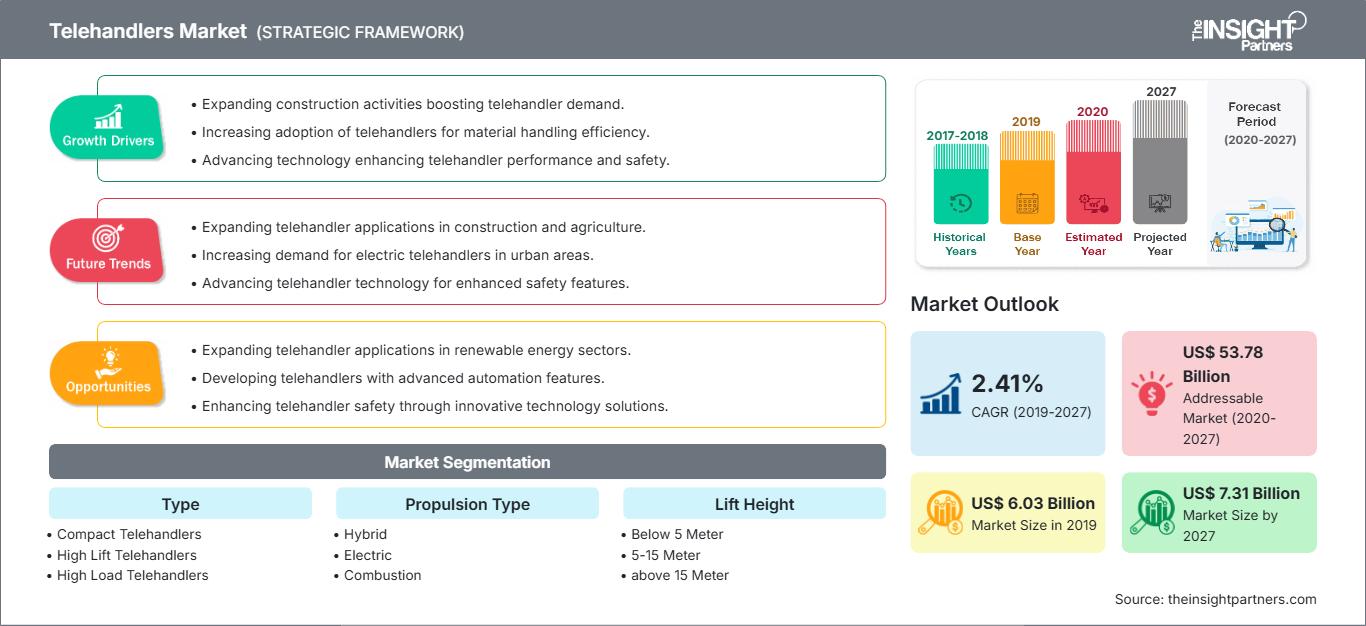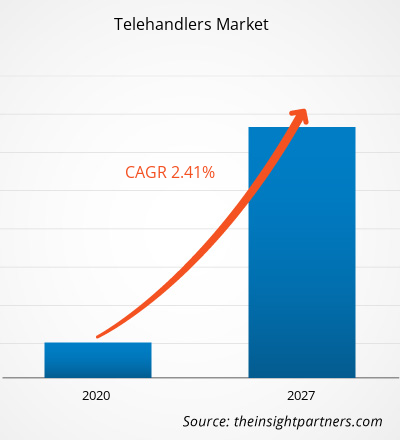[Informe de investigación] El mercado de manipuladores telescópicos se valoró en 6.030 millones de dólares estadounidenses en 2019 y se espera que crezca a una tasa de crecimiento anual compuesta (TCAC) del 2,41% entre 2020 y 2027, hasta alcanzar los 7.310 millones de dólares estadounidenses en 2027.
El mercado de manipuladores telescópicos ha experimentado un crecimiento notable a nivel mundial en los últimos años. Factores como el aumento de proyectos mineros, agrícolas y de infraestructura impulsan la demanda de equipos de construcción, incluyendo manipuladores telescópicos, en todo el mundo. Además, el auge de la tecnología inteligente y la introducción de manipuladores telescópicos eléctricos también contribuyen a este crecimiento. Aparte de la construcción, el sector agrícola desempeña un papel fundamental en el estímulo de la demanda de manipuladores telescópicos. Estados Unidos, China, India y Brasil se encuentran entre los países más importantes dedicados a la agricultura. El manipulador telescópico es un equipo mecánico utilizado en diversas industrias como la minería, la silvicultura, la construcción y la agricultura. Su uso es muy común en los mercados norteamericano y europeo, mientras que en el mercado asiático su adopción es menor. En Asia, se utilizan otras máquinas alternativas, como las minigrúas. Sin embargo, el continuo crecimiento económico de los países asiáticos podría brindar a los proveedores de manipuladores telescópicos una plataforma para expandir su mercado en economías emergentes con gran potencial.
Perspectivas del mercado
Crecimiento del sector minero y de la construcción
El crecimiento impulsado por la infraestructura en países como China ha generado un alto crecimiento económico y un aumento en la demanda de materias primas como el mineral de hierro, el carbón, el manganeso, el cobalto y el cobre. La exploración de los minerales y metales necesarios es fundamental para el crecimiento general de la industria minera. Además, el crecimiento de los proyectos de infraestructura y el desarrollo urbano impulsan la demanda de equipos de construcción. Debido al aumento de los proyectos de infraestructura a nivel mundial, crece la necesidad de equipos con tecnologías sofisticadas para garantizar una mayor productividad.
Debido a los factores mencionados anteriormente, se espera que el mercado de manipuladores telescópicos crezca.
Obtendrá personalización gratuita de cualquier informe, incluyendo partes de este informe, análisis a nivel de país y paquetes de datos de Excel. Además, podrá aprovechar excelentes ofertas y descuentos para empresas emergentes y universidades.
Mercado de manipuladores telescópicos: Perspectivas estratégicas

-
Obtenga las principales tendencias clave del mercado que se describen en este informe.Esta muestra GRATUITA incluirá análisis de datos, que abarcarán desde tendencias de mercado hasta estimaciones y pronósticos.
Impacto del Covid-19 en el mercado de manipuladores telescópicos:
La pandemia de COVID-19 (coronavirus) de 2019-2020 tuvo un gran impacto en la sociedad, la salud pública y la economía en general. Además, provocó el caos en numerosos sectores, como la construcción, la manufactura y la minería. Para frenar la propagación del virus, varias empresas están tomando medidas para garantizar la seguridad y el bienestar de sus empleados. Los proyectos de construcción se han paralizado durante el brote de COVID-19. Asimismo, las industrias manufactureras han cerrado sus instalaciones debido al confinamiento. Por ejemplo, JLG Industries ha suspendido la producción en Estados Unidos y Francia, mientras que en China y Rumania las instalaciones operan con personal reducido. El cierre o la producción a baja capacidad son los principales factores que afectarán aún más a sectores como la construcción, que son los principales usuarios finales de estos equipos, y que, en última instancia, repercutirán en la adopción de manipuladores telescópicos.
Información sobre tipos
Según su tipo, el mercado de manipuladores telescópicos se segmenta en manipuladores telescópicos compactos, de gran altura y de carga elevada. El segmento de manipuladores de gran altura domina el mercado global. El creciente desarrollo de la construcción y la minería a nivel mundial exige el uso de manipuladores telescópicos de gran altura para optimizar las operaciones, permitiendo elevar cargas pesadas a grandes alturas. Estos manipuladores también se utilizan en la construcción, la manufactura, el almacenamiento, la minería y la extracción de áridos.
Información sobre los tipos de propulsión
El mercado de manipuladores telescópicos, según su tipo de propulsión, se divide en híbridos, de combustión y eléctricos. El segmento de combustión domina el mercado global de manipuladores telescópicos. Estos, que utilizan motores de combustión interna, emplean diversos combustibles como gasolina, gas licuado de petróleo (GLP), diésel y gas natural comprimido.
Información sobre la capacidad de elevación
Según su capacidad de elevación, el mercado de manipuladores telescópicos se segmenta en menos de 3 toneladas, de 3 a 10 toneladas y más de 10 toneladas. El segmento de 3 a 10 toneladas domina el mercado global de manipuladores telescópicos. Estos equipos son altamente compatibles con una amplia gama de accesorios gracias al sistema RFID, que reconoce automáticamente la creación de tablas de carga dinámicas para satisfacer las diversas necesidades de los sectores de la fabricación y la construcción.
Información sobre la altura del ascensor
El mercado de manipuladores telescópicos, según su altura de elevación, se divide en tres segmentos: menos de 5 metros, de 5 a 15 metros y más de 15 metros. El segmento de 5 a 15 metros domina el mercado global de manipuladores telescópicos. Estos manipuladores, con alturas entre 5 y 15 metros, están diseñados para ofrecer los más altos niveles de productividad y rendimiento, junto con bajos costos operativos, una versatilidad excepcional, una calidad de fabricación superior y una amplia gama de implementos.
Información sobre el usuario final
El mercado de manipuladores telescópicos, según el usuario final, se segmenta en construcción, agricultura, minería, silvicultura y otros. El sector de la construcción domina el mercado global de manipuladores telescópicos. El creciente sector de la construcción, junto con el desarrollo de la infraestructura sanitaria, social y educativa a nivel mundial, demanda manipuladores telescópicos para la elevación de cargas.
Las empresas suelen adoptar iniciativas de mercado y nuevas estrategias de desarrollo para expandir su presencia mundial y satisfacer la creciente demanda. Estas estrategias se observan principalmente en Norteamérica y Europa. Los actores del mercado de manipuladores telescópicos adoptan la estrategia de expansión e inversión en investigación y desarrollo para ampliar su base de clientes a nivel mundial, lo que también les permite mantener su prestigio de marca a nivel global.
Perspectivas regionales del mercado de manipuladores telescópicos
Los analistas de The Insight Partners han explicado en detalle las tendencias regionales y los factores que influyen en el mercado de manipuladores telescópicos durante el período de previsión. Esta sección también analiza los segmentos del mercado de manipuladores telescópicos y su distribución geográfica en Norteamérica, Europa, Asia Pacífico, Oriente Medio y África, y Sudamérica y Centroamérica.
Alcance del informe de mercado de manipuladores telescópicos
| Atributo del informe | Detalles |
|---|---|
| Tamaño del mercado en 2019 | 6.030 millones de dólares estadounidenses |
| Tamaño del mercado para 2027 | 7.310 millones de dólares estadounidenses |
| Tasa de crecimiento anual compuesto global (2019 - 2027) | 2,41% |
| Datos históricos | 2017-2018 |
| período de previsión | 2020-2027 |
| Segmentos cubiertos |
Por tipo
|
| Regiones y países cubiertos |
América del norte
|
| Líderes del mercado y perfiles de empresas clave |
|
Densidad de actores del mercado de manipuladores telescópicos: comprensión de su impacto en la dinámica empresarial
El mercado de manipuladores telescópicos está creciendo rápidamente, impulsado por la creciente demanda de los usuarios finales debido a factores como la evolución de las preferencias de los consumidores, los avances tecnológicos y una mayor conciencia de las ventajas del producto. A medida que aumenta la demanda, las empresas amplían su oferta, innovan para satisfacer las necesidades de los consumidores y aprovechan las nuevas tendencias, lo que impulsa aún más el crecimiento del mercado.

- Obtenga una visión general de los principales actores del mercado de manipuladores telescópicos.
Mercado global de manipuladores telescópicos – Por tipo
- Manipulador telescópico compacto
- manipulador telescópico de gran altura
- manipulador telescópico de alta carga
Mercado global de manipuladores telescópicos – Por tipo de propulsión
- Híbrido
- Combustión
- Eléctrico
Mercado global de manipuladores telescópicos – Por altura de elevación
- Menos de 5 metros
- 5 - 15 metros
- Más de 15 metros
Mercado global de manipuladores telescópicos – Por capacidad de elevación
- Menos de 3 toneladas
- 3 - 10 toneladas
- Más de 10 toneladas
Mercado global de manipuladores telescópicos – Por tipo de equipo
- Construcción
- Agricultura
- Minería
- Silvicultura
- Otros
Mercado de manipuladores telescópicos – Por geografía
-
América del norte
- A NOSOTROS
- Canadá
- México
-
Europa
- Francia
- Alemania
- Italia
- Reino Unido
- Rusia
- El resto de Europa
-
Asia Pacífico
- Porcelana
- India
- Australia
- Corea del Sur
- Japón
- Resto de Asia Pacífico
-
Oriente Medio y África
- Sudáfrica
- Arabia Saudita
- Emiratos Árabes Unidos
- Resto de Oriente Medio y África
-
Sudamerica
- Brasil
- Argentina
- El resto de Sudamérica
Perfiles de empresas
- AB Volvo
- Compañía Bobcat
- Caterpillar Inc.
- CNH Industrial NV
- Grupo Hauloutte
- JLG Industries, Inc.
- Komatsu Ltd.
- Grupo Liebherr
- Manitou BF
- Corporación Terex
- Análisis histórico (2 años), año base, pronóstico (7 años) con CAGR
- Análisis PEST y FODA
- Tamaño del mercado, valor/volumen: global, regional y nacional
- Industria y panorama competitivo
- Conjunto de datos de Excel
Informes recientes
Testimonios
Razón para comprar
- Toma de decisiones informada
- Comprensión de la dinámica del mercado
- Análisis competitivo
- Información sobre clientes
- Pronósticos del mercado
- Mitigación de riesgos
- Planificación estratégica
- Justificación de la inversión
- Identificación de mercados emergentes
- Mejora de las estrategias de marketing
- Impulso de la eficiencia operativa
- Alineación con las tendencias regulatorias






















 Obtenga una muestra gratuita para - Mercado de manipuladores telescópicos
Obtenga una muestra gratuita para - Mercado de manipuladores telescópicos